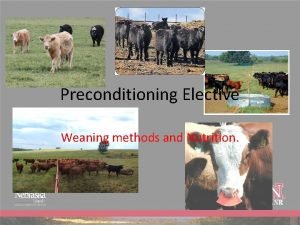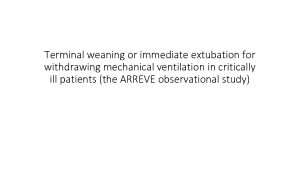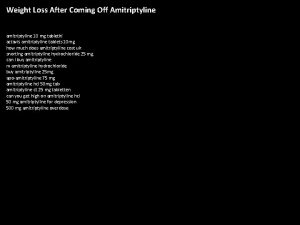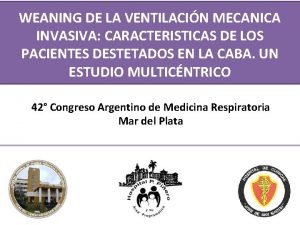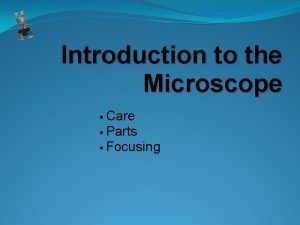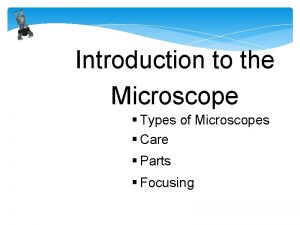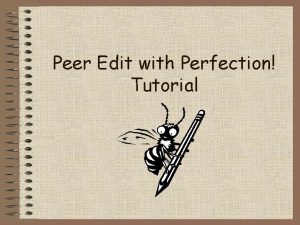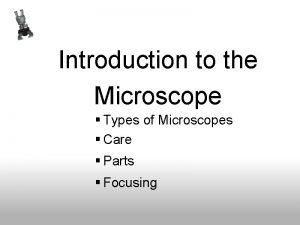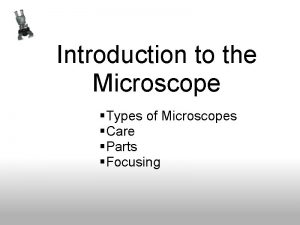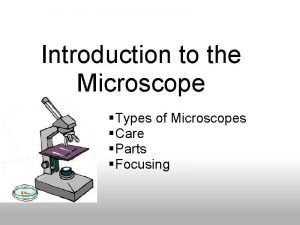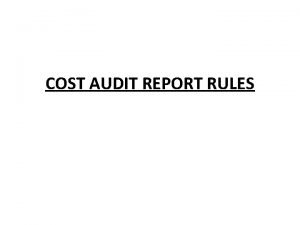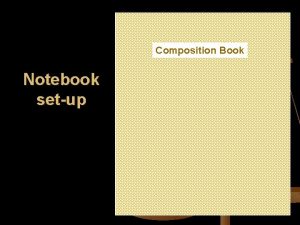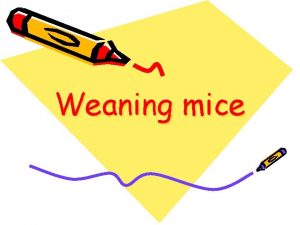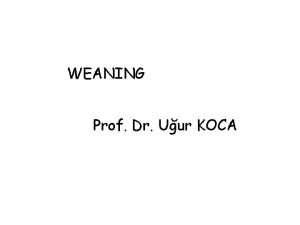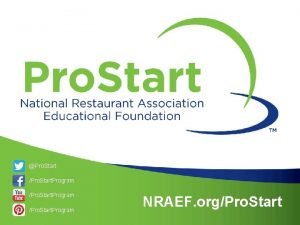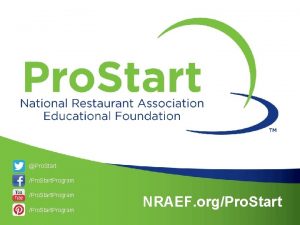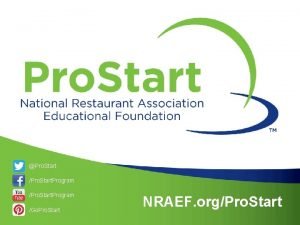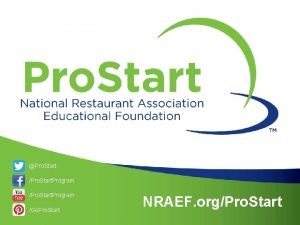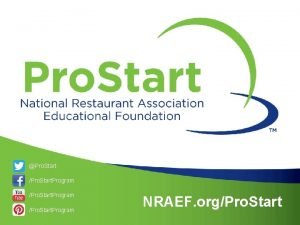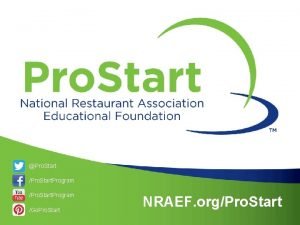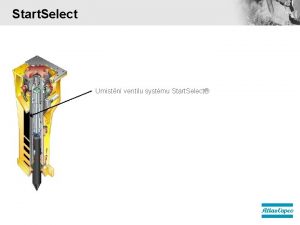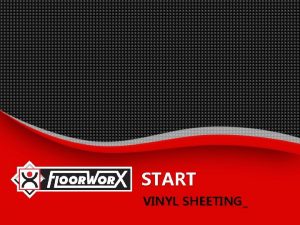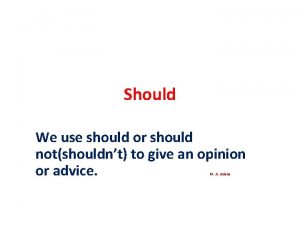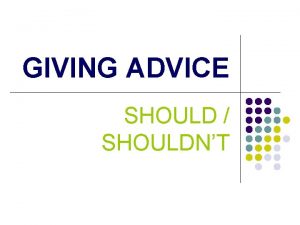Weaning Workshop Contents o When should I start





























- Slides: 29

Weaning Workshop

Contents o When should I start weaning my baby? o What are the best first foods for my baby? o What is baby led weaning? o How do I wean my baby? Mealtime routine, portion sizes and tops weaning tips o Drinks o Vitamin Drops Slide 2

When Should I Wean my Baby? • The Department of Health (Do. H) recommend introducing solid foods at around 6 months (Do. H 2004) • For the first 6 months of life your baby can get all the nutrients and energy he/she needs from milk alone • Solid foods should not be introduced earlier than 4 months (17 weeks)

Signs of Readiness Look out for signs that your baby is ready to start solid foods e. g. • Watching you or others eating and showing a keen interest in what you’re doing • The ability to grab objects and put them into their mouths • Sucking, chewing on fists or other objects like toys (although this is a typical developmental skill and can develop much earlier than 6 m) • Copying you when you’re eating. Mimicking the chewing action • Seeming more hungry than usual. Perhaps the milk doesn’t seem to be satisfying your baby as much as is used. Look for a combination of these signs, don’t feel rushed into it. You will know what is right for your baby.

Not too soon…. . • Baby’s gut & kidneys are immature (diarrhoea/constipation) • Possible risk of choking • Baby may be more likely to suffer from infections • Inappropriate use of food to comfort Slide 5

Not too late…. . • After 6 months breast/formula milk cannot give baby all the nutrition he/she needs • Refusal to accept solids • Refusal to accept lumpy or mashed foods • Poor acceptance of “family foods” • Difficulty adapting to the spoon or finger foods

Suitable First Foods • Vegetables especially green vegetables eg. broccoli, spinach, cabbage, green beans, kale, avocado, courgetti, runner beans • Other vegetables: carrots, butternut squash, swede, sweet potato, parsnip, • Baby rice (made with baby’s usual milk), baby porridge (go for plain flavours) potato or other starchy foods • Pureed or mashed lentils, beans, pulses • Fruits eg. banana, pear, mango, apple, peach, apricot, melon, nectarine, Slide 7

Stage 1 Foods Slide 8

Stage 1 Foods

Baby Led Weaning or Purees? Baby led weaning • Another way of describing self feeding • Offer pieces/fingers of foods which your baby can grab and put into their mouths themselves • Food should be roughly the size of an adults index finger and soft enough to bite through with gums • The baby has control over what they put in their mouth

The Gag Reflex • The gag reflex is a protective reflex that prevents the ingestion of pieces of food that are too large to be comfortably swallowed • As the infant gets more used to lumpy foods in the mouth, the gag reflex usually declines • Head to Catherine Lippe Nutrition Facebook Page for more info on the gag reflex and a useful video to demonstrate what it looks like in real life

Baby Led V’s Purees Advantages of baby led weaning Disadvantages of baby led weaning • Encourages chewing • It takes time • Baby may be less likely to be fussy when they are older* • Difficult to ensure variety and good nutrition • Less need to prepare something different for baby • Not all foods are suitable for baby led weaning especially at first • Baby becomes more used to family foods • It will be messy • Baby cannot be force fed More food wastage • • • *BLW has not been tested in a randomised control trial and there is insufficient evidence to suggest that it has better long term feeding outcomes than traditional feeding practices *Observation studies suggest that it may support acceptance of a wider range of textures and flavours (SACN 2016)

Are there any foods I should avoid? Foods to Avoid Before 12 Months • Salt and foods that contain added salt • Sugar and foods that contain added sugar • Honey (until 1 year) • Hot chillies • Unpasteurised cheeses • Shark, swordfish and marlin Foods to Limit • Liver – no more than once per week • Oily fish such as salmon, sardines, pilchards, fresh tuna, trout, herrings -No more than twice per week Slide 13

What about Food Allergies? The following foods are considered higher risk allergen foods and should be introduced one at a time after your baby turns 6 months • Cow’s milk products such as cheese, yoghurts, custard, (cow’s milk shouldn’t be given as a drink until 12 m but can be introduced in cooking and as an ingredient from 6 m) • Wheat or gluten based products such as bread, pasta, breakfast cereals, and other foods made from wheat, oats, barley, rye) • Nuts and seeds and foods that contain them • Eggs • Fish and shellfish • Celery • Soy Continuing with breastfeeding throughout weaning can help to minimise the risk of developing allergic diseases

Mealtime Routine and Top Tips • Vegetables first, vegetables frequently and vegetables in variety • Start slowly, 1 meal per day and then gradually increase to 2 and then 3 meals a day by 7 months • Chose whatever time of day fits best with your routine, think about the timing of milk feeds, is baby too full, too hungry, too tired? • Start with 2 -3 spoonfuls or mouthfuls and let baby guide you. • Look out for signs of fullness and avoid force feeding • Eat together, smile, make eye contact, relax and make yummy noises! • If baby is not interested, don’t worry. Try again the next day. Slide 15

Stage 1 Menu Planner Weaning Workshop

Stage 1 Menu Planner

Stage 2 Tips (from 7 months) Weaning Workshop

Stage 2 Weaning: from around 7 months • Move on to mashed or minced texture • Introduce a wider range of tastes • 2 -3 servings of starchy foods, 2 -3 serving of fruits/vegetables, 1 serving of meat, fish or pulses daily • Encourage chewing by offering finger foods even if you’re not following baby led weaning • Introduce drinks from a free flow cup at 6 months • Continue breastfeeding on demand or offer about 560 ml/17 oz formula milk per day in addition to food Slide 19

Stage 2 textures Minced and Mashed

Stage 2 finger foods

Stage 2 Menu Planner Weaning Workshop

Stage 2 Menu Planner

Stage 3 Weaning: 10 -12 months • Chopped or minced foods • Aim for family foods by 1 year • Give 3 meals + 1 -2 snacks • Encourage self-feeding • Continue breast or formula milk on demand between meals. Milk intake may begin to reduce slightly at this stage • By 1 year babies should be taking ALL drinks from a cup Slide 24

Stage 3 Menu Planner Weaning Workshop

Stage 3 Menu Planner

Drinks • Water is the best drink for your baby at mealtimes • From 6 months your baby can drink freshly drawn tap water • Offer a small amount of water with each mealtimes in a free flow cup or beaker or open top cup • Avoid fruit juices, squash and baby teas. They often taste sweet and can be acidic resulting in eroded tooth enamel • Continue to offer baby’s usual milk (breast or formula milk) on demand throughout the rest of the day • Whole cow’s milk can be introduced as a main drink from 12 months old Slide 27

Vitamin Drops • Vitamin D is recommended for infants for optimum bone and musculoskeletal health. • Infants from birth-12 months are recommended to have 8. 5 mcg 10 mcg daily unless receiving more than 500 ml of formula milk daily • From 12 months – 5 years a multivitamin containing vitamins A, C and D is recommended daily • Pregnant and breastfeeding women are also recommended to take a vitamin D supplement (10 mcg) daily • All other women (and men) are recommended to take a vitamin D supplement of 10 mcg daily from the October to April Slide 28

Questions Weaning Workshop Catherine Lippe RNutr (PH) BSc www. catherinelippenutrition. co. uk
 China weaning fence
China weaning fence China weaning fence
China weaning fence Terminal weaning vs immediate extubation
Terminal weaning vs immediate extubation Ecmo heparin dose
Ecmo heparin dose Ventilator weaning
Ventilator weaning Weaning ventilation
Weaning ventilation Weaning oksigen
Weaning oksigen Weight loss after stopping amitriptyline
Weight loss after stopping amitriptyline Simplified weaning index
Simplified weaning index Weaning prolongado
Weaning prolongado Principles of weaning slideshare
Principles of weaning slideshare Tidal volume normal range
Tidal volume normal range Site:slidetodoc.com
Site:slidetodoc.com Start/jump start triage algorithm
Start/jump start triage algorithm When focusing a specimen, you should always start with the
When focusing a specimen, you should always start with the Types of microscopes
Types of microscopes Peer edit with perfection tutorial
Peer edit with perfection tutorial Three types of microscope
Three types of microscope Different types of microscope and their uses
Different types of microscope and their uses When focusing a specimen you should always start with the
When focusing a specimen you should always start with the Contents provider
Contents provider Democritus atom modeli
Democritus atom modeli Medial aspect of antecubital fossa
Medial aspect of antecubital fossa Table of content for company profile
Table of content for company profile Screw home mechanism
Screw home mechanism Cost audit report
Cost audit report What does key characteristics mean
What does key characteristics mean Science logbook example
Science logbook example Interactive notebook table of contents
Interactive notebook table of contents Composition notebook table of contents
Composition notebook table of contents
